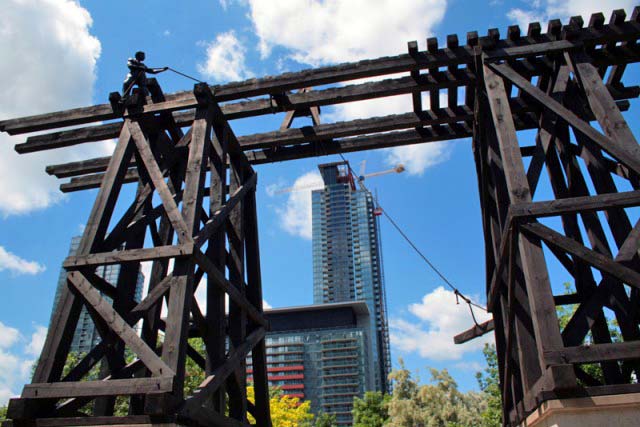
Toronto Ontario - One man reaches up towards the large wooden log, big enough to crush him, and braces himself against the trestle.
Another man stands high on top, directing the log with just a rope, pulling it up to build the next tie on a railroad.
This scene would have been common across the country as workers built the Canadian Pacific railway from coast to coast in the 1800s.
Now, these men, cast in bronze, stand near the Rogers Centre in Toronto, as a permanent reminder of the thousands of workers, many of them Chinese labourers,
overworked and underpaid, who died building that railroad.
It's Rail Safety Week and 28 Apr 2016 is the annual Workers Day of Mourning, and so it's a particularly relevant time to look at the lives and deaths of the
Chinese railroad labourers, who worked in dangerous conditions and died in large numbers.
Estimates of how many Chinese workers died building the railroad vary widely.
The grim saying, immortalized in an iconic Heritage Minute is that one Chinese worker died for every mile of track laid.
The Canadian Encyclopedia, published by Historica Canada, which also makes Heritage Minutes, uses the estimate "at least 600" dead in its
articles.
The memorial puts the number at over 4,000.
Records of the deaths of Chinese workers were poorly kept by railroad foremen, and the 600 figure seems to come from Andrew Onderdonk, who supervised
construction on British Columbia sections of the railway and gave testimony at the Royal Commission on the Canadian Pacific Railway.
Based on contemporary descriptions of Chinese workers dying and the poor record-keeping, the other estimates of deaths are much higher.
Workers died in landslides, cave-ins, from disease, drowning, and explosions.
Blasting tunnels through the mountains of B.C. made it the most dangerous, time-consuming, and deadly section of the railroad.
Around 15,000 Chinese workers were brought in between 1880 and 1885 to work on the railroad in B.C., mostly from southern provinces including Guangdong, and
paid around half of what other workers made ($1 a day to the $2-$2.50 other labourers got).
They faced racism from many in B.C., partly because workers were concerned that Chinese immigrants were willing to work for less, and discrimination from their
supervisors on the railroad, who paid them little, forced them to buy supplies from the company store, gave them the most dangerous jobs, and gave them little
access to healthcare.
Even those who survived building the railroad often couldn't afford to return to China or bring their families to Canada.
They were left without jobs in hostile territory.
The railroad workers memorial notes that it also memorializes these men, saying, "With no means of going back to China when their labour was no longer
needed, thousands drifted in near destitution along the completed track. All of them remained nameless in the history of Canada."
The Last Spike on the railroad joining the coasts was famously driven in at Craigellachie, B.C. on 7 Nov 1885.
That same year, Canada imposed a "head tax" on Chinese immigrants, initially set at $50 a person.
The tax was later raised to $500 before Chinese immigration was banned in 1923.
Prime Minister John A. Macdonald had previously supported some Chinese immigration, saying, "It is simply a question of alternatives, either you must have
this labour, or you can't have the railway."
By 1885, he had changed his tune and argued in Parliament that Chinese immigrants were not adding anything to Canada, saying, "When the Chinaman comes
here he intends to return to his own country, he does not bring his family with him, he is a stranger, a sojourner in a strange land, for his own purposes for
a while, he has no common interest with us, and while he gives us his labour and is paid for it, and is valuable the same as a threshing machine... that money
does not fructify in Canada."
On 22 Jun 2006 Prime Minster Stephen Harper gave a full apology for the Chinese head tax and for the ban on Chinese immigration from 1923-1947, calling them
"malicious measures aimed solely at the Chinese."
The Workers Memorial was funded by the Foundation to Commemorate the Chinese Railroad Workers in Canada, led by James Pon.
In 2004, Pon told the Toronto Star his father had to pay a $500 head tax to bring him to Canada in 1922, and it took 17 years to pay off the debt.
The Workers Memorial, including the trestle arch and sandstone blocks carved to represent the Canadian Rockies, was built in 1989 and designed by prominent
Toronto artist Eldon Garnet.
The bronze figures were cast by Francis LeBouthillier.
The foundation, along with the Multicultural History Society on Ontario, has an online exhibition called "The Ties That Bind" about the history of
Chinese-Canadian labourers and building the railroad.
The foundation also offers the annual James Pon Memorial Scholarship to honour the man who led the push for greater acknowledgment of the contributions and
sacrifices made by Chinese railroad workers.
Erin Sylvester.


